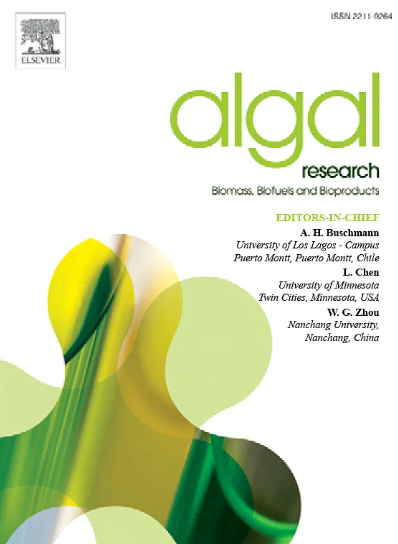Improved lipid production in Chlorella sp. UJ-3 using Fe3O4 nanoparticles assisted by an alternating magnetic field and transcriptome analysis
IF 4.6
2区 生物学
Q1 BIOTECHNOLOGY & APPLIED MICROBIOLOGY
Algal Research-Biomass Biofuels and Bioproducts
Pub Date : 2025-06-17
DOI:10.1016/j.algal.2025.104147
引用次数: 0
Abstract
In this study, a process intensification strategy combining magnetic Fe₃O₄ nanoparticles (NPs) and an alternating magnetic field (MF) was employed to enhance lipid production in Chlorella sp. UJ-3. Among the tested MFs at various frequencies, the alternating MF at 200 Hz demonstrated the most significant promotion of cell growth and lipid production. Under this treatment, biomass increased by 64.5 %, and total lipid production was enhanced by 170.8 % compared to the untreated control. With the MF and Fe₃O₄ NPs treatment, algal cells regulated their antioxidant defense system, resulting in increased activities of related antioxidant enzymes to counteract the elevated reactive oxygen species induced by the MF and Fe₃O₄ NPs. The regulatory mechanism of Fe₃O₄ NPs on Chlorella sp. metabolism under a MF was analyzed at the transcriptome level. The addition of Fe₃O₄ NPs promoted the synthesis and desaturation of fatty acids while reducing their β-oxidation. The expression of most enzyme genes in the glycolytic pathway were downregulated, while several enzyme genes in the pentose phosphate pathway were upregulated. The expression of superoxide dismutase and catalase genes was also upregulated under Fe₃O₄ NPs treatment. This study provides an efficient method for enhancing lipid production in microalgal cells and offers valuable insights into the biological effects of magnetic NPs on algal metabolism.
在交变磁场和转录组分析的辅助下,利用Fe3O4纳米颗粒改善小球藻UJ-3的脂质生成
采用磁性Fe₃O₄纳米颗粒(NPs)和交变磁场(MF)相结合的工艺强化策略,提高了小球藻UJ-3的脂质生成。在不同频率的被测MF中,200 Hz的交变MF对细胞生长和脂质产生的促进作用最为显著。与未处理的对照相比,该处理的生物量提高了64.5%,总脂质产量提高了170.8%。通过MF和Fe₃O₄NPs处理,藻细胞调节了它们的抗氧化防御系统,导致相关抗氧化酶的活性增加,以抵消MF和Fe₃O₄NPs诱导的活性氧含量升高。从转录组水平分析了Fe₃O₄NPs在MF条件下对小球藻代谢的调控机制。Fe₃O₄NPs的加入促进了脂肪酸的合成和去饱和,同时减少了脂肪酸的β-氧化。糖酵解途径中大部分酶基因表达下调,而戊糖磷酸途径中部分酶基因表达上调。Fe₃O₄NPs处理也上调了超氧化物歧化酶和过氧化氢酶基因的表达。本研究为提高微藻细胞的脂质生成提供了一种有效的方法,并为磁性NPs对藻类代谢的生物学效应提供了有价值的见解。
本文章由计算机程序翻译,如有差异,请以英文原文为准。
求助全文
约1分钟内获得全文
求助全文
来源期刊

Algal Research-Biomass Biofuels and Bioproducts
BIOTECHNOLOGY & APPLIED MICROBIOLOGY-
CiteScore
9.40
自引率
7.80%
发文量
332
期刊介绍:
Algal Research is an international phycology journal covering all areas of emerging technologies in algae biology, biomass production, cultivation, harvesting, extraction, bioproducts, biorefinery, engineering, and econometrics. Algae is defined to include cyanobacteria, microalgae, and protists and symbionts of interest in biotechnology. The journal publishes original research and reviews for the following scope: algal biology, including but not exclusive to: phylogeny, biodiversity, molecular traits, metabolic regulation, and genetic engineering, algal cultivation, e.g. phototrophic systems, heterotrophic systems, and mixotrophic systems, algal harvesting and extraction systems, biotechnology to convert algal biomass and components into biofuels and bioproducts, e.g., nutraceuticals, pharmaceuticals, animal feed, plastics, etc. algal products and their economic assessment
 求助内容:
求助内容: 应助结果提醒方式:
应助结果提醒方式:


